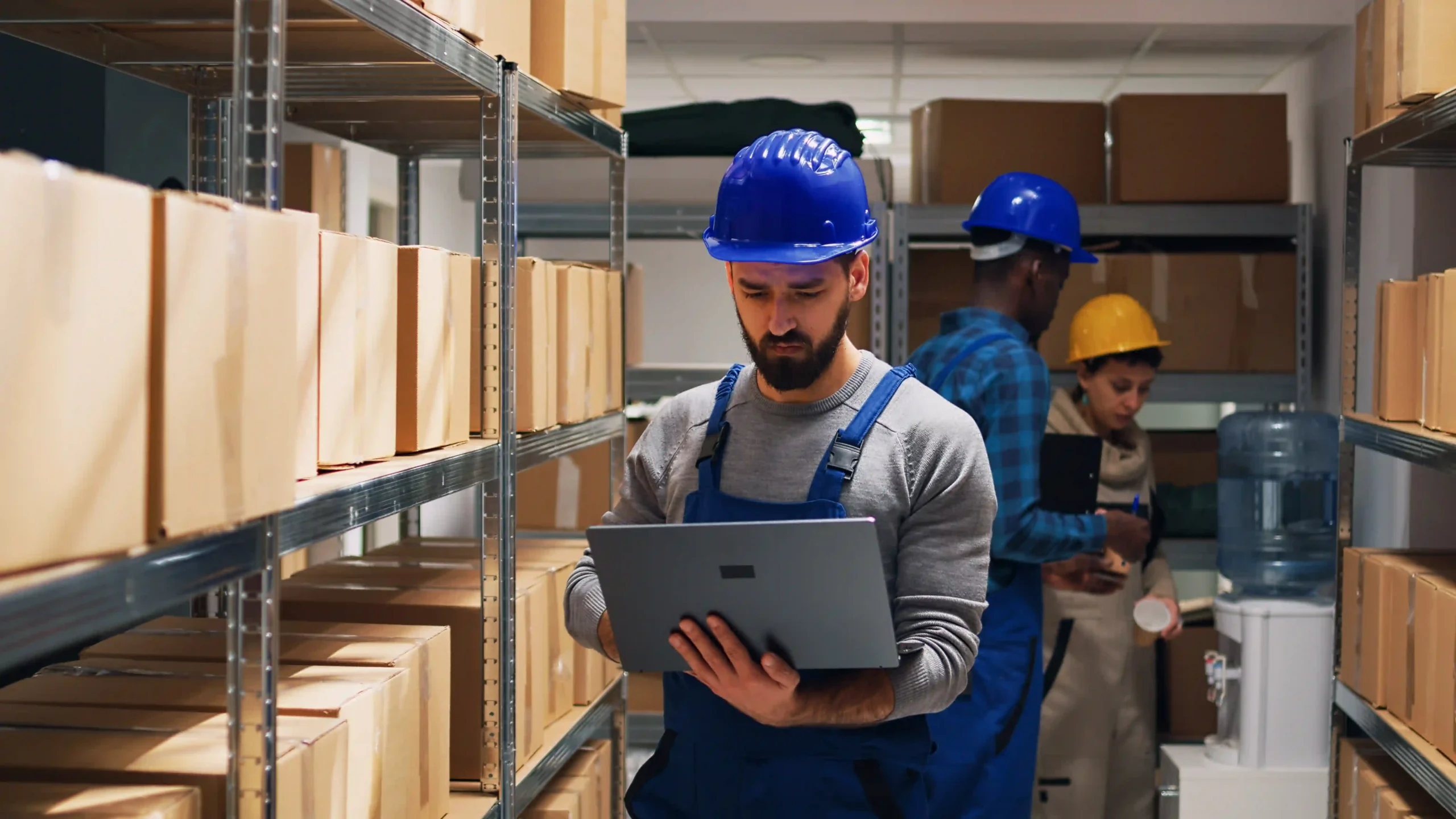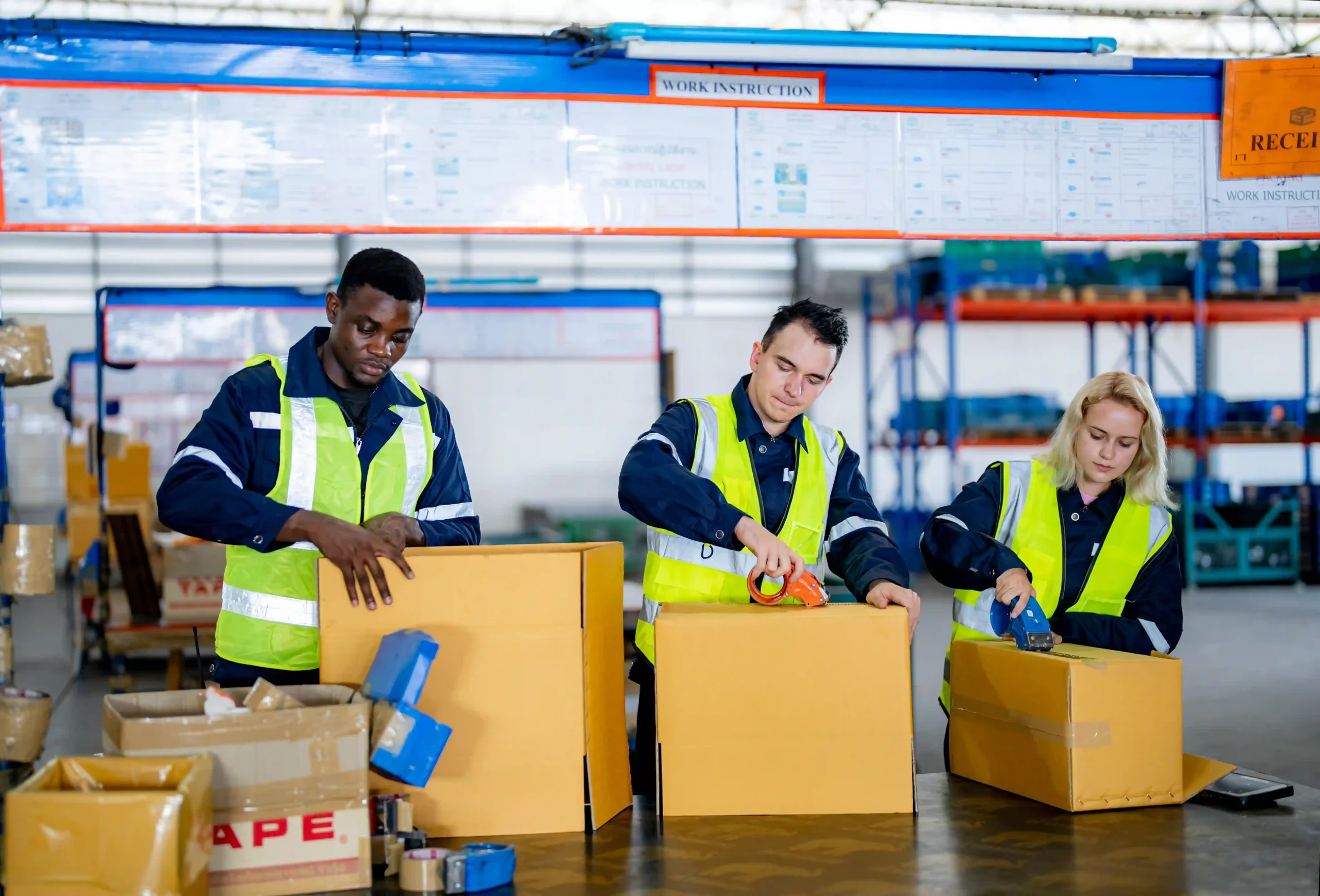Order fulfillment and distribution is the process of managing, packing, shipping, and delivering customer orders to the right place at the right time. It includes everything from receiving inventory into a warehouse, to processing orders, to handing off that product to a carrier, and even handling returns if needed.
Distribution adds the layer of transportation—how goods move between facilities, stores, or end customers. While these two terms are closely linked, fulfillment focuses on getting individual customer orders right, while distribution handles broader logistics across regions or markets.
At Tri-Link FTZ, we’ve been in the business of order fulfillment and distribution for over 35 years. I’ve watched these terms evolve from old-school warehouse operations to complex, tech-driven strategies that now define competitive advantage. What used to take days now happens in hours—or minutes—and if you’re not ahead of the curve, you’re falling behind.

When I speak with clients—whether they’re startups or Fortune 500 giants—one truth stands out: if you can’t get your product into your customer’s hands quickly and accurately, you’ve already lost the sale. Order fulfillment and distribution isn’t just a backend process.
It’s customer experience, brand reputation, and profitability rolled into one. In today’s market, people expect next-day or even same-day delivery.
If your operations aren’t built to support that, customers will simply buy from someone else. Over the years at Tri-Link FTZ, we’ve built flexible systems that allow our clients to pivot fast—whether it’s due to seasonal spikes or global disruptions like port congestion or labor shortages.
I can’t tell you how many times we’ve stepped in to save a business’s reputation just by getting their fulfillment pipeline flowing smoothly again. You also have to look at your cost structure. Delays, mispicks, and excess inventory all bleed money.
When your order fulfillment and distribution systems are fine-tuned, they become profit centers instead of cost sinks. Add the layer of compliance—especially if you’re moving goods internationally through a Foreign Trade Zone like ours—and the importance of getting this right becomes crystal clear. Read more here.
Many people confuse fulfillment with distribution. Let’s set the record straight.
Fulfillment is about delivering on the promise to the individual customer: when they click “Buy,” the wheels are in motion. Inventory is picked, packed, labeled, and shipped. Distribution, on the other hand, is about the larger picture. It involves moving goods between factories, ports, warehouses, and retailers.
It’s about managing fleets, transit times, and logistics networks. At Tri-Link FTZ, we manage both under one roof. That’s our edge.
By integrating fulfillment and distribution, we eliminate the silos that slow businesses down. We’ve worked with brands that previously used separate vendors for warehousing and transportation, and they were losing days and dollars in the gap.
By combining those services, we give them visibility and speed they didn’t know was possible. Whether you sell through e-commerce, wholesale, or retail, this difference matters.
When fulfillment and distribution don’t talk to each other, it creates lag. When they do, you scale faster, respond better, and grow more profitably.
If you’re feeling the pain of fulfillment and distribution problems, you’re not alone. We’ve seen it all—overstocked warehouses, out-of-stock inventory during peak season, skyrocketing shipping costs, you name it.
These challenges often stem from three main issues: lack of visibility, poor planning, and disconnected systems. One client came to us with a growing DTC brand.
They were doing great in sales, but their order accuracy was just 87%. That meant nearly 1 in 7 customers got the wrong item or experienced a delay.
We stepped in, implemented real-time inventory tracking, redesigned their picking strategy, and improved their shipping integrations. Within 60 days, their accuracy jumped to 99.6%.
Another challenge is the lack of coordination between warehouse staff and logistics teams. When orders spike unexpectedly, traditional systems break. That’s why we’ve invested in automation, smart analytics, and zone picking at our facilities.
It lets us scale on demand without skipping a beat. And then there’s international trade.
Many businesses don’t understand the added value of using a Foreign Trade Zone. As an FTZ operator, we help clients defer duties, reduce fees, and improve their global shipping timelines—all while staying fully compliant.

This is a question I get all the time: “When should I stop doing this myself and bring in a 3PL like Tri-Link?” My answer is simple—when logistics is slowing down your growth instead of supporting it, it’s time.
If your team is spending more time fixing order errors than building your product, it’s time. If your shipping costs are eating your margins, it’s time.
We’ve had clients come in who were fulfilling orders out of their garage. That’s a great way to start, but not a way to scale.
Once your order volume hits a few hundred per month, outsourcing fulfillment becomes a strategic move, not just a convenience. At Tri-Link, we take over the heavy lifting—literally and figuratively.
We bring decades of knowledge, trained staff, advanced systems, and a nationwide logistics network to your business. More importantly, we treat your brand like it’s our own.
That’s how we’ve kept clients for decades.
Not all 3PLs are created equal. Trust me, I’ve worked in this business long enough to know.
If you’re going to outsource, you need a partner who brings more than just boxes and forklifts. Look for someone who offers real-time inventory tracking, customized reporting, and multi-channel integration—especially if you’re selling on Amazon, Shopify, or in big-box retail.
You also want a partner that understands the regulatory landscape. If you’re importing goods, working with a Foreign Trade Zone operator like Tri-Link FTZ can save you serious money on duties and taxes.
We help our clients avoid penalties, delays, and compliance headaches. Another must-have is transparent pricing.
You don’t want to get nickel-and-dimed on hidden storage or handling fees. And make sure your partner has the scalability to grow with you.
We’ve helped brands scale from 1,000 orders per month to 100,000 per month without changing facilities or systems. Most of all, look for a partner who listens.
We’ve built our business on long-term relationships, not transactions. That starts with communication, responsiveness, and a shared commitment to success.
In the early years of Tri-Link FTZ, most of our processes were manual. Pallet jacks, paper pick sheets, and walkie-talkies were the norm.
Fast forward to today, and I can tell you with full confidence: technology has transformed how we approach order fulfillment and distribution. It’s no longer about working harder—it’s about working smarter.
We’ve adopted warehouse management systems (WMS) that track inventory in real time. This means our clients can log in from anywhere in the world and see exactly what’s in stock, what’s shipping, and what needs to be replenished.
That kind of visibility is a game-changer. It reduces errors, cuts down customer inquiries, and makes decision-making faster.
Artificial intelligence and machine learning are starting to play a huge role too. We use predictive analytics to understand order patterns and demand spikes.
This helps us stock more efficiently and avoid over- or under-buying. Automation also shines in picking and packing.
We’ve implemented zone-based picking systems that cut walking time and speed up order completion. It’s not unusual for one of our pickers to handle 150+ orders an hour.
The magic happens when all these technologies are connected. When your ecommerce platform, your inventory system, your shipping software, and your returns portal all talk to each other, fulfillment becomes seamless.
We help our clients integrate all of that, so they don’t have to waste time managing tech stacks—they just grow. Read more here.

This is where most companies get stuck. They think outsourcing is expensive—but they forget to tally up what it really costs to run fulfillment in-house.
I always walk clients through a simple breakdown, and usually, they’re shocked at how much they’re spending without realizing it. Here’s a snapshot of typical in-house costs:
Expense Category | Monthly Estimate (Small Business) |
Warehouse rent/utilities | $6,000+ |
Staff wages (2–3 workers) | $8,000+ |
Packing materials | $1,500 |
Software/tech tools | $800 |
Shipping carrier rates | Varies, often higher than 3PLs |
Insurance, errors, returns | $1,000–$2,000 |
Total Estimate | $17,300+ |
Now compare that to working with a 3PL like Tri-Link FTZ. We already have the space, staff, equipment, and software.
Our clients only pay for the space and labor they actually use. Plus, we negotiate better shipping rates due to our volume—savings that we pass along.
Most importantly, our clients can scale up or down without the headaches of hiring, firing, or renegotiating leases. One of our ecommerce clients switched from in-house fulfillment to working with us, and in the first three months, they reduced costs by 28% and increased shipping speed by 35%.
That’s the kind of ROI that makes outsourcing a no-brainer when the time is right.
Let me say this clearly: speed matters. In today’s market, consumers have been conditioned by giants like Amazon to expect fast, cheap, and accurate delivery.
If you can’t match those expectations, you lose sales. We once helped a brand that was averaging 4–6 day delivery windows.
They were losing customers to competitors who could deliver in 2 days or less. Once we onboarded them to our system, integrated our carriers, and set up fulfillment from multiple zones, we got their average delivery time down to 1.8 days.
The result? A 20% bump in repeat purchases within 60 days.
Customers don’t just notice fast shipping—they remember it. They come back because it builds trust. It tells them your business is reliable, efficient, and customer-first.
On the flip side, slow or delayed orders lead to abandoned carts, negative reviews, and refund requests. But it’s not just about delivery speed.
Faster fulfillment also reduces inventory carrying costs, increases cash flow, and shortens the time between sale and satisfaction. It’s a full-cycle win.
Inventory is the fuel for your entire fulfillment engine. If your inventory isn’t accurate, nothing else can run properly.
I can’t tell you how many times we’ve worked with companies who had great products, great marketing—but terrible inventory visibility. When you don’t know what you have, you either oversell (and disappoint customers) or undersell (and lose sales you could have fulfilled).
Neither is good. That’s why our fulfillment services always start with strong inventory practices.
We sync data across all platforms, set up smart reorder points, and use cycle counts to make sure every SKU is accounted for.
At Tri-Link FTZ, we’ve even developed custom inventory dashboards for clients who sell on multiple platforms—Shopify, Amazon, and retail. This gives them one central source of truth and reduces guesswork.
We’ve seen clients go from weekly stockouts to 99.9% availability with just a few system upgrades. Inventory control also supports better demand planning.
With historical sales data, we can forecast spikes and prepare early—especially for seasonal businesses. Whether it’s Black Friday or back-to-school, the goal is to keep inventory flowing so fulfillment never stops.

If you’re not measuring, you’re just guessing. Every fulfillment strategy needs real metrics.
We work with our clients to track performance using key indicators, and we review these reports regularly so we can tweak, improve, and grow together. Here are a few core metrics we use at Tri-Link FTZ:
We provide our clients with customized dashboards and automated reporting. That way, they’re not just hoping things are going well—they know it.
And if anything starts to slip, we’re there to fix it before it becomes a bigger issue.
We’ve spent over 35 years building something special at Tri-Link FTZ. We’re not just a warehouse.
We’re a logistics partner, a growth accelerator, and an operations engine for businesses that want to scale smarter. From order fulfillment and distribution to FTZ benefits and compliance, we handle the complexities so our clients can focus on what they do best—building great products and serving their customers.
Our team operates out of secure, bonded FTZ facilities in strategic locations with proximity to major ports, interstates, and population centers. We’re licensed, insured, and fully integrated with modern logistics software. More importantly, we care.
Whether you’re shipping 1,000 units or 1,000,000, you’ll get white-glove service and a team that treats your inventory like it’s our own. From our headquarters to your customer’s front door, we’re the invisible engine behind successful brands.
And if your company is ready to take fulfillment to the next level, we’re ready to help.
In a connected world, fulfillment can’t stop at the border. Many of the clients we serve at Tri-Link FTZ ship internationally.
That comes with its own unique challenges: customs paperwork, duty fees, long transit times, and, most importantly, customer expectations across different countries. That’s where our expertise as a Foreign Trade Zone operator really shines.
We help businesses go global without the usual friction. Our FTZ allows companies to store goods without immediately paying duties.
That’s huge for cash flow. Even better, it gives companies more time to inspect, repackage, or even alter inventory before it enters domestic commerce.
I’ve worked with brands who saved tens of thousands of dollars a year simply by routing through our FTZ instead of shipping direct to the customer from overseas. Cross-border fulfillment also requires strong systems integration.
You need to sync product data, customs codes, inventory locations, and shipping platforms. That’s why we work closely with customs brokers and provide full compliance oversight.
Mistakes in global distribution aren’t just inconvenient—they’re expensive. We exist to prevent that.
Our goal is to make global order fulfillment and distribution just as seamless as local. Whether you’re shipping to Canada, Brazil, Europe, or anywhere else, we’ve got the infrastructure and know-how to do it right.

Not every business needs the same fulfillment solution. That’s why understanding your options—and when to use them—is so important.
Over the years, we’ve helped brands test and switch between multiple fulfillment models until they found the right fit. And sometimes, the right answer isn’t one model—it’s a combination.
Let me walk you through the big ones:
Self-Fulfillment:
This works when you’re starting small or have a hyper-customized product. It gives you total control but quickly becomes hard to scale. You’ll run into limits on space, labor, and shipping rates. Most of our clients graduate from self-fulfillment as they grow.
Third-Party Logistics (3PL):
This is what we offer at Tri-Link FTZ. You hand off your inventory and orders to us, and we handle everything else—storage, picking, packing, shipping, returns, and reporting. This model gives you scale, speed, and savings.
Dropshipping:
Great for startups or product testers. With dropshipping, you don’t hold inventory. You take the order and pass it to a supplier who ships it for you. The downside? Less control and lower margins. But it’s a solid way to test new markets without upfront cost.
Hybrid Fulfillment:
This is the sweet spot for many growing businesses. You might ship custom products in-house but use a 3PL for everyday SKUs. Or maybe you use dropshipping for bulky items and store the rest. We help clients set up hybrid systems all the time—and the flexibility pays off.
Choosing the right model isn’t just about price—it’s about strategy. We sit down with every client to assess their product line, target markets, and growth plans before recommending the best fit.
Fulfillment should match your business—not the other way around.
These days, your customers might find you anywhere—Instagram, Amazon, your website, even a pop-up shop in a local mall. They expect a consistent experience no matter how or where they buy.
That’s where omnichannel fulfillment comes in. We help clients sync orders across all platforms.
One system. One inventory source. One promise to the customer—kept.
Whether it’s BOPIS (Buy Online, Pick Up In-Store), ship-from-store, or traditional delivery, our job is to make sure it works flawlessly. If a customer returns something they bought online to a retail store, your system should already be ready for it.
I’ve seen brands struggle with this. They run different systems for each channel and spend hours trying to reconcile inventory.
It leads to stockouts, double-selling, and frustrated customers. When we onboarded one such client, we integrated all their channels into a single fulfillment platform.
The result? 99.7% order accuracy and a 15% drop in customer service tickets. The future is not single-channel.
If your fulfillment doesn’t support omnichannel selling, you’re already behind. Let us help you fix that.
If there’s one thing I’ve learned over 35 years in logistics, it’s this: fulfillment is never just about moving boxes. It’s about moving your business forward.
It’s about creating a customer experience that keeps people coming back. And it’s about giving you the freedom to scale without limits.
Order fulfillment and distribution might be behind the scenes—but they’re where your brand really comes to life. Every delivery is a chance to prove your promise.
Every return is a test of your systems. And every touchpoint is an opportunity to win or lose a loyal customer.
At Tri-Link FTZ, we’ve spent decades perfecting the infrastructure, systems, and relationships needed to support growing businesses like yours. From our strategically located FTZ warehouses to our tech-forward approach to logistics, we’re built to make fulfillment feel frictionless.
Whether you’re just getting started or looking to scale globally, we’re here to help. We’ll take the time to understand your needs, customize a plan that fits, and deliver the kind of results that make your brand stand out in a crowded marketplace.
Your supply chain shouldn’t hold you back—it should set you free. Let’s build something great together.
Share this article
We have other resources available upon request as well as one-on-one support and personalized answers, just like our services.
Simply contact us anytime and we’ll get back to you to answer your questions and provide meaningful answers that show you how Tri-Link supports your logistics, reduces costs, and accelerates efficiency.
Tri-Link delivers exceptional FTZ and 3PL services tailored to your global trade needs.
Our solutions combine innovation, quality, and efficiency to exceed your expectations and meet your specific requirements.